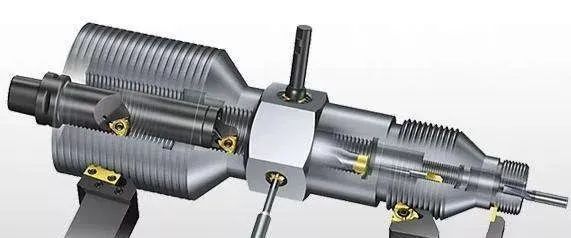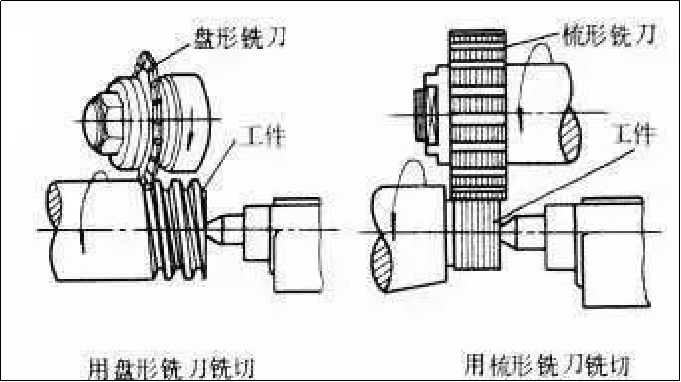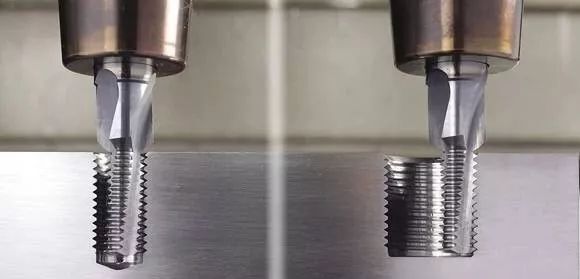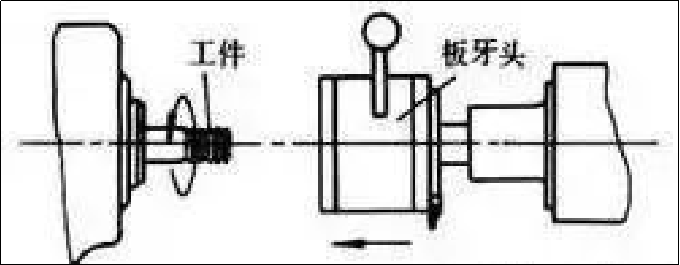How much do you know about the processing method of thread in CNC machining?
In CNC machining, threads are typically created by cutting or forming operations. Here are a few commonly used thread processing methods provided by Anebon team:
Tapping: This method involves cutting threads using a tap, which is a tool with helical grooves. Tapping can be done either by hand or using a machine, and it is suitable for creating internal threads.
Thread Milling: Thread milling utilizes a rotating cutting tool with multiple flutes to create threads. It is a versatile method that can be used for both internal and external threads. Thread milling is often preferred for larger threads or when a variety of thread sizes and types are required.
Thread Turning: This method involves using a single-point cutting tool mounted on a lathe to create external threads. Thread turning is commonly used for large or long threads and is suitable for both straight and tapered threads.
Thread Rolling: In thread rolling, a hardened steel die applies pressure to the workpiece to deform the material and form the threads. This method is efficient and produces high-quality threads, making it suitable for high-volume production.
Thread Grinding: Thread grinding is a precision machining process that uses a grinding wheel to create threads. It is often employed for high-accuracy and high-quality thread production, especially for complex or specialized threads.
When selecting a thread processing method, factors such as thread size, accuracy requirements, material properties, production volume, and cost considerations should be taken into account.
History
The English word corresponding to screw is Screw. The meaning of this word has changed a lot in recent hundreds of years. At least in 1725, it means “mating”.
The application of the thread principle can be traced back to the spiral water-lifting tool created by the Greek scholar Archimedes in 220 BC.
In the 4th century AD, countries along the Mediterranean Sea began to apply the principle of bolts and nuts to presses used for brewing wine. At that time, the external threads were all wrapped with a rope to a cylindrical bar, and then engraved according to this mark, while the internal threads were often formed by hammering around the external threads with softer materials.
Around 1500, in the sketch of the thread processing device drawn by the Italian Leonardo da Vinci, there was already the idea of using the female screw and the exchange gear to process threads of different pitches. Since then, the method of mechanically cutting threads has developed in the European watchmaking industry.
In 1760, British brothers J. Wyatt and W. Wyatt obtained a patent for cutting wood screws with a special device. In 1778, the British J. Ramsden once manufactured a thread cutting device driven by a worm gear pair, which could process long threads with high precision. In 1797, the British H. Mozley used the female lead screw and exchange gear to turn metal threads with different pitches on the lathe improved by him, and established the basic method of turning threads.
In the 1820s, Maudsley manufactured the first batch of taps and dies for thread processing.
At the beginning of the 20th century, the development of the automobile industry further promoted the standardization of threads and the development of various precision and efficient thread processing methods. Various automatic opening die heads and automatic shrinking taps were invented one after another, and thread milling began to be applied.
In the early 1930s, thread grinding appeared.
Although the thread rolling technology was patented in the early 19th century, due to the difficulty in mold manufacturing, the development was very slow. It was not until the Second World War (1942-1945) that due to the needs of munitions production and the development of thread grinding technology, the problem was solved. The precision problem of mold manufacturing has achieved rapid development.
The thread is mainly divided into connecting thread and transmission thread
For connecting threads, the processing methods are mainly: tapping, threading, threading, rolling, rolling, etc.
For the transmission thread, the main processing methods are: rough and fine turning—grinding, whirlwind milling—rough and fine turning, etc.
The first category: thread cutting
Generally refers to the method of processing threads on workpieces with forming tools or abrasive tools, mainly including turning, milling, tapping and thread grinding, grinding and whirlwind cutting. When turning, milling and grinding threads, every time the workpiece rotates, the transmission chain of the machine tool ensures that the turning tool, milling cutter or grinding wheel moves a lead accurately and evenly along the axis of the workpiece. When tapping or threading, the tool (tap or die) and the workpiece make relative rotational movement, and the first formed thread groove guides the tool (or workpiece) to move axially.
1. Thread turning
Turning threads on a lathe can use a forming turning tool or a thread comb. Turning thread with a forming turning tool is a common method for single-piece and small-batch production of threaded workpieces due to the simple structure of the tool; turning thread with a thread comb tool has high production efficiency, but the tool structure is complex and is only suitable for medium and large-scale production Turning short threaded workpieces with fine pitch. The pitch accuracy of trapezoidal thread turning on ordinary lathes can generally only reach grades 8 to 9 (JB2886-81, the same below); processing threads on specialized thread lathes can significantly improve productivity or accuracy.
2. Thread milling
Prototype cnc milling with a disc cutter or comb cutter on a thread milling machine.
Disc milling cutters are mainly used for milling trapezoidal external threads on workpieces such as screw rods and worms. The comb-shaped milling cutter is used for milling internal and external ordinary threads and taper threads. Since it is milled with a multi-edged milling cutter and the length of its working part is greater than the length of the processed thread, the workpiece only needs to be rotated for 1.25 to 1.5 turns to process. Done, the productivity is high. The pitch accuracy of thread milling can generally reach 8-9 grades, and the surface roughness is R5-0.63 microns. This method is suitable for batch production of threaded workpieces with general precision or rough machining before grinding.
Thread milling cutter machining internal thread
3. Thread grinding
It is mainly used to process precision threads of hardened workpieces on thread grinding machines. According to the shape of the cross-section of the grinding wheel, it can be divided into two types: single-line grinding wheel and multi-line grinding wheel. The pitch accuracy of the single-line grinding wheel grinding can be 5-6 grades, the surface roughness is R1.25-0.08 microns, and the dressing of the grinding wheel is more convenient. This method is suitable for grinding precision lead screws, thread gauges, worms, small batches of threaded workpieces and relief grinding precision turned component.
Multi-line grinding wheel grinding is divided into two types: longitudinal grinding method and plunge grinding method. In the longitudinal grinding method, the width of the grinding wheel is smaller than the length of the thread to be ground, and the thread can be ground to the final size by moving the grinding wheel longitudinally once or several times. In the cut-in grinding method, the width of the grinding wheel is greater than the length of the thread to be ground.
The grinding wheel cuts into the surface of the workpiece radially, and the workpiece can be ground after about 1.25 revolutions. The productivity is high, but the precision is slightly lower, and the dressing of the grinding wheel is more complicated. The plunge grinding method is suitable for relief grinding taps with large batches and grinding some threads for fastening.
4. Thread grinding
The nut-type or screw-type thread grinder is made of soft materials such as cast iron, and the cnc turning parts of the processed thread on the workpiece that has a pitch error is rotated in the forward and reverse directions to improve the pitch accuracy. Hardened internal threads are usually also ground to eliminate deformation and improve accuracy.
5. Tapping and threading
Tapping
It is to use a certain torque to screw the tap into the pre-drilled bottom hole on the workpiece to process the internal thread.
Threading
It is to use the die to cut the external thread on the bar (or pipe) workpiece. The machining accuracy of tapping or threading depends on the accuracy of the tap or die.
Although there are many methods for processing internal and external threads, small-diameter internal threads can only be processed by taps. Tapping and threading can be done by hand, or by lathes, drill presses, tapping machines and threading machines.
The second category: thread rolling
A processing method in which the workpiece is plastically deformed by a forming rolling die to obtain threads. Thread rolling is generally carried out on a thread rolling machine or an automatic lathe with an automatic opening and closing thread rolling head. External threads for mass production of standard fasteners and other threaded connections. The outer diameter of the rolled thread is generally not more than 25 mm, the length is not more than 100 mm, the thread accuracy can reach level 2 (GB197-63), and the diameter of the blank used is roughly equal to the pitch diameter of the processed thread. Rolling generally cannot process internal threads, but for workpieces with soft materials, grooveless extrusion taps can be used to cold-extrude internal threads (the maximum diameter can reach about 30 mm), and the working principle is similar to tapping. The torque required for cold extrusion of internal threads is about
Twice that of tapping, and the machining accuracy and surface quality are slightly higher than those of tapping.
Advantages of thread rolling: ①The surface roughness is smaller than that of turning, milling and grinding; ②The surface of the thread after rolling can increase the strength and hardness due to cold hardening; ③High material utilization; ④The productivity is doubled compared with cutting processing , and easy to automate; ⑤ rolling die life is very long. However, the rolling thread requires that the hardness of the workpiece material does not exceed HRC40; the requirement for the dimensional accuracy of the blank is high; the precision and hardness of the rolling mold are also high, and it is difficult to manufacture the mold; it is not suitable for rolling threads with asymmetric tooth shapes.
According to the different rolling dies, thread rolling can be divided into two types: thread rolling and thread rolling.
6. Rubbing
Two thread rolling boards with thread profile are arranged opposite to each other with 1/2 pitch staggered, the static board is fixed, and the moving board makes a reciprocating linear motion parallel to the static board. When the custom machined parts is fed between the two plates, the moving plate moves forward and rubs the workpiece, making its surface plastically deformed to form threads (Figure 6 [thread rolling]).
7. Thread rolling
There are 3 types of thread rolling, radial thread rolling, tangential thread rolling and rolling head thread rolling.
① Radial thread rolling: 2 (or 3) thread rolling wheels with thread profile are installed on parallel shafts, the workpiece is placed on the support between the two wheels, and the two wheels rotate at the same speed in the same direction (Figure 7 [Radial thread rolling]), one of which also makes radial feed motion. The workpiece rotates under the drive of the thread rolling wheel, and the surface is radially extruded to form threads. For some lead screws that do not require high precision, a similar method can also be used for roll forming.
②Tangential thread rolling: Also known as planetary thread rolling, the rolling tool consists of a rotating central thread rolling wheel and 3 fixed arc-shaped wire plates (Figure 8 [tangential thread rolling]). During thread rolling, the workpiece can be fed continuously, so the productivity is higher than that of thread rolling and radial thread rolling.
③Rolling head thread rolling: It is carried out on an automatic lathe, and is generally used to process short threads on workpieces. There are 3 to 4 thread rolling wheels evenly distributed on the outer periphery of the workpiece in the rolling head (Figure 9 [thread rolling head]). During thread rolling, the workpiece rotates, and the rolling head feeds axially to roll the workpiece out of the thread.
8. EDM thread processing
Ordinary thread processing generally uses machining centers or tapping equipment and tools, and sometimes manual tapping is also possible. However, in some special cases, the above method is not easy to obtain good processing results, such as the need to process threads after heat treatment of parts due to negligence, or due to material constraints, such as direct tapping on cemented carbide workpieces. At this time, it is necessary to consider the machining method of EDM.
Compared with the metal cnc machining method, the order of EDM is the same, and the bottom hole needs to be drilled first, and the diameter of the bottom hole should be determined according to the working conditions. The electrode needs to be processed into a thread shape, and the electrode needs to be able to rotate during processing.
“Quality initial, Honesty as base, Sincere company and mutual profit” is Anebon’s idea, so that you can create consistently and pursue the excellence for China Wholesale Custom Machining Part-Sheet Metal Part Factory-Auto Part, Anebon quickly grew in size and name because of Anebon’s absolute dedication to superior quality manufacturing, large value of goods and great customer provider.
OEM Manufacturer China Machining Part and Stamping Part, If you have to have any of Anebon’s products and solutions, or have other objects to be produced, be sure to send us your inquiries, samples or in depth drawings. Meanwhile, aiming to develop into an international enterprise group, Anebon will be always here to look forward to receiving offers for joint ventures and other cooperative projects.
Post time: Jun-19-2023





